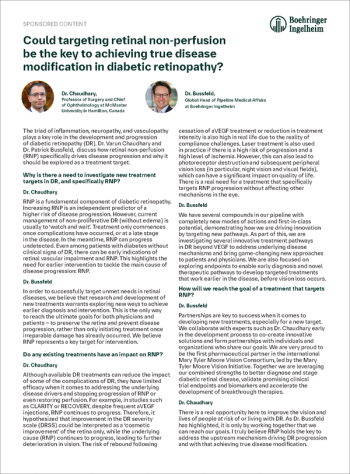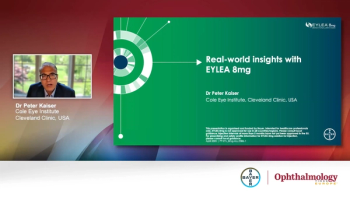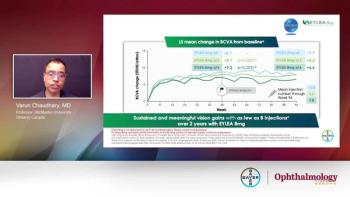
UNCOVERING HIDDEN PREDATORS IN DISEASE
This article is produced by Roche for healthcare professionals and is not intended to provide medical advice and/or treatment guidance. This website is not country-specific and therefore may contain information which is not applicable to your country.
Explore the eye-opening breakthroughs that revealed nature's most cunning pathological mechanisms
Diseases possess an extraordinary ability to outwit us. No matter how much progress we make hidden predators still lurk, wreaking havoc from the shadows while our focus lies elsewhere. The potential benefits of finding them are what keep researchers thinking and patients hoping.
The Ophthalmology world has recently uncovered its own hidden predator in DME and nAMD - Angiopoietin-2 (Ang-2). As the story of its dual-action mechanism unfolds, acting both as an independent driver of disease and an amplifier of the more notorious VEGF, we explore some other extraordinary pathological tales of the unexpected.
The bacterial intruder behind gastritis and peptic ulcers
We start with a story that's as famous for its scientific method as it is for its discovery.
Psychosocial factors, such as stress, were once considered the main cause of gastritis and gastric ulcers.1 Two researchers, Barry Marshall and Arthur Morris, suspected otherwise, focusing instead on a seemingly innocuous bacterium, Helicobacter Pylori.2
In their legendary experiments, these gastric pioneers tested the effects of H.Pylori colonization in the most personal way possible - by ingesting it.3,4 Both developed gastritis, demonstrating that H.Pylori induces inflammation of the gastric mucosa.2,3,4
The role of H.Pylori as a bacterial intruder has since been linked with a variety of upper gastrointestinal disorders, like mucosa-associated lymphoid tissue lymphoma and gastric cancer,2 but it's not the only significant hidden predator in our midst.
The cloaking device for cancer
Our immune systems are well attuned to differentiating friend from foe. It's what keeps us healthy and protects us from disease. We now know cancer cells have evolved to exploit this to their advantage.
In their ground-breaking work, Tasuku Honjo and team discovered that cancer cells express large amounts of programmed-death ligand-1 (PDL-1), a marker found on healthy cells.5,6 This PDL-1 coat creates a cloaking device, making the cancer appear normal to T cells and preventing the immune system from locating and destroying the cancer on its own.5,6,7
By hiding behind our body's own immune processes, cancers demonstrate the remarkable ability to avoid detection. But there are other ways pathological predators have remained hidden from researchers.
The agitator behind thyroid-associated ophthalmopathy (TAO)
Some pathological processes in ophthalmopathy have been hiding in the shadows, not masked by a cloak, but by more notorious pathways.
In TAO, a complication of Grave's disease, the thyroid-stimulating hormone (TSH) pathway has traditionally been the focal pathological process.8,9 Pathogenic TSH antibodies disrupt signalling within the pathway, leading to hyperthyroidism.10
Here, the plot thickens. Pathogenic insulin-like growth factor-1 (IGF-1) antibodies stoke the disease process by activating the IGF-1 pathway, sensitizing the body to the already devastating effects of TSH dysfunction.9
Intriguingly, blocking IGF-1 receptor (IGF-1R) activation can block signaling initiated by TSH,9 suggesting IGF-1 may actually control the TSH pathway. This not only increases suspicion around TSH, but also around pathogenic IGF-I antibodies as the unexpected agitator behind the TAO pathophysiology.9
However, these aren't the only pathological pathways in ophthalmology to behave with a potentially destructive duality.
The hidden accomplice behind DME and nAMD
For 15 years, VEGF has held the spotlight in retinal diseases like DME and nAMD.11 We now know it is not the only driver of the vascular instability that fuels these diseases. Its hidden accomplice, Ang-2, also plays a significant role through its interaction with the Tie2 receptor.12
The Ang-2/Tie2 pathway independently drives disease while simultaneously amplifying the negative effects of VEGF. These two pathways promote a damaging combination of inflammation, leakage and pathological neovascularization that can lead to a devastating loss of vision.12 It's clear there's potentially more to DME and nAMD than meets the eye.
As we seek to understand and outsmart our most challenging diseases, every hidden predator we uncover helps us take one step forward in advancing science.
---
References:
- Deding U, et al. Perceived stress as a risk factor for peptic ulcers: a register-based cohort study. BMC gastroenterology. 2016 Dec;16(1):1-2.
- Kusters JG, et al. Pathogenesis of Helicobacter pylori infection. Clinical microbiology reviews. 2006 Jul 1;19(3):449-90.
- Marshall BJ, et al. Attempt to fulfil Koch's postulates for pyloric Campylobacter. Medical Journal of Australia. 1985 Apr;142(8):436-9.
- Morris A, Nicholson G. Ingestion of Campylobacter pyloridis causes gastritis and raised fasting gastric pH. American Journal of Gastroenterology (Springer Nature). 1987 Mar 1;82(3).
- Iwai Y, et al. Involvement of PD-L1 on tumor cells in the escape from host immune system and tumor immunotherapy by PD-L1 blockade. Proceedings of the National Academy of Sciences. 2002 Sep 17;99(19):12293-7.
- Iwai Y, et al. PD-1 blockade inhibits hematogenous spread of poorly immunogenic tumor cells by enhanced recruitment of effector T cells. International immunology. 2005 Feb 1;17(2):133-44.
- UT Southwestern Medical Center. How cancer cells don their invisibility cloaks [Internet]. ScienceDaily. 2020 [cited January 27, 2021]. Available from:
www.sciencedaily.com/releases/2020/04/200421112555.htm - Şahlı E, Gündüz K. Thyroid-associated ophthalmopathy. Turkish journal of ophthalmology. 2017 Apr;47(2):94.
- Smith TJ, et al. Role of insulin-like growth factor-1 (IGF-1) pathway in the pathogenesis of Graves’ orbitopathy. Best practice & research Clinical endocrinology & metabolism. 2012 Jun 1;26(3):291-302.
- Mohyi M, Smith TJ. 40 years of IGF1: IGF1 receptor and thyroid-associated ophthalmopathy. Journal of molecular endocrinology. 2018 Jul 1;61(1):T29-43.
- Ferrara N, Adamis AP. Ten years of anti-vascular endothelial growth factor therapy. Nature reviews Drug discovery. 2016 Jun;15(6):385-403.
- Heier JS, et al. The angiopoietin/Tie pathway in retinal diseases: A Review. Retina. 2021 Jan 1;41(1):1-9.
Veeva code: M-XX-00004126 (v2.0). Date of preparation: July 2021
Newsletter
Keep your retina practice on the forefront—subscribe for expert analysis and emerging trends in retinal disease management.






































